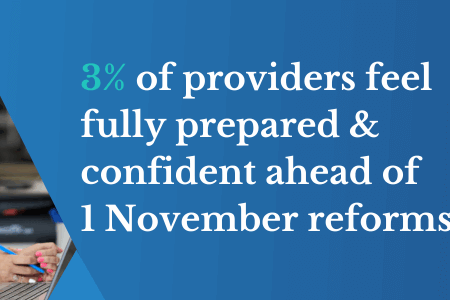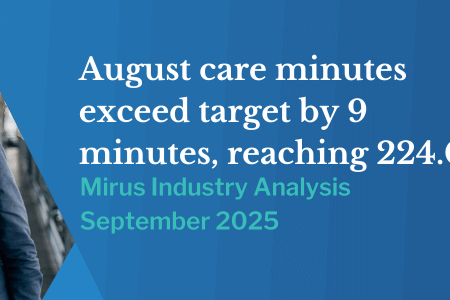How to avoid funding clawbacks and prepare for care minute audits in 4 steps
July 22, 2025 | Care Minutes

By Chris Lyons, Senior Consultant
With the countdown to October 2025 well underway, aged care providers must move decisively to protect funding and prepare for a new era of compliance scrutiny. Care minute performance in Q2 (October to December 2025) will directly influence funding from April 2026 (for MM1 providers), while also contributing to the audited Care Minutes Performance Statement due by October 2026.
This shift introduces both operational and financial pressure and makes early action essential. Below are four practical steps your organisation can take now to minimise funding risk and get ahead of the upcoming care minute audits.
1. Align policies, Position descriptions and Role allocations
The foundation of care minute compliance is a clear and defensible policy. With recent updates to the Care minutes responsibility, providers must ensure their internal documentation reflects the latest expectations around role eligibility and audit readiness.
Key changes include the clarification that to claim time as a personal care worker, the role’s primary responsibility must be the delivery of personal care. This means that lifestyle and leisure roles are no longer claimable unless they are employed and rostered primarily as personal care workers under RN & EN supervision.
To ensure alignment:
- Review and update care minute policies to reflect the latest definitions and exclusions
- Audit every claimed role to confirm it meets the primary responsibility test
- Update position descriptions for hybrid or managerial roles to clearly outline direct care duties
- Adjust or remove claims for roles (e.g., Lifestyle Coordinators) that no longer qualify under the revised rules
Without this alignment, providers risk audit failure, disallowed minutes, and clawbacks. Ensuring your documentation matches operational practice is the first step toward a defensible, compliant care minute framework.
2. Confirm current compliance and forecast future targets
October is not just a deadline; it’s the beginning of compliance linked to funding. The care minute targets delivered between October and December 2025 (Q2) will impact both:
- Subsidy adjustments from April 2026, and
- Your first audited Performance Statement, due October 2026
To prepare, providers must:
- Confirm each site’s Q1 care minute target
- Forecast Q2 targets (October to December 2025) based on expected AN-ACC reclassifications and admissions
- Model whether current staffing will meet these targets across both RN and total care minutes
For MM1 facilities, this step is especially important. Falling short could result in funding reductions of up to $31.64 per resident per day.
3. Strengthen recordkeeping and internal controls
Care minute audits are fast approaching, and accurate, auditable records are critical. Providers should now:
- Differentiate direct care from non-care time in rosters and timesheets
- Use consistent job titles and role codes that align with payroll and rostering systems
- Keep version-controlled care minute policies and supporting documentation on file
Even if your service is delivering the right level of care, poor documentation could still result in minutes being rejected in audit.
4. Embed cross-functional care minute reviews
Meeting care minute targets is not just a task for finance or rostering — it requires coordinated effort across teams. Now is the time to embed:
- Weekly or fortnightly care minute reviews between finance, funding and rostering
- Use of forecasting and tracking tools to monitor compliance and identify future unplanned increases to care minute targets
- Communication loops between managers and frontline staff to understand workforce impacts
Providers who build this routine into business-as-usual will be more responsive, accurate, and better prepared for ongoing compliance and audits.
Take control with Care Minute Manager
Avoid guesswork and get audit-ready with Care Minute Manager — the only solution that combines policy alignment, real-time AN-ACC classification insights, and live care minute tracking in one streamlined platform.
Our setup includes:
- Care minute policy creation or review aligned to the latest Department guidelines
- Real-time visibility into care minutes delivered by site and by shift
- Direct access to resident-level AN-ACC classifications to forecast funding and future care minute targets
- Built-in audit reports so every minute claimed is supported by evidence
- Dedicated support across two full quarters to embed processes and ensure compliance
With care minute compliance now tied directly to funding, you need more than spreadsheets. You need clarity, confidence and control.
Talk to us today to prepare for October and protect your funding.


